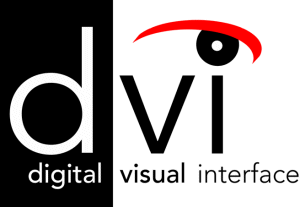A number of digital interfaces already exist, but only DVI has come close to emerging as an industry standard. For example, current notebook systems use a low voltage differentail signaling (LVDS) digitial interface to their liquid crystal display panels, but this technology does not transition very well to external desktop displays. Other digital interfaces such as Digital Flat Panel (DFP), VESA® Plug and Display, and OpenLDI have also failed to achieve widespread acceptance. In contrast, DVI is widely expected to become the standard digital interface for flat panels, as well as high definition televisions. The specificication was developed by the Digital Display Working Group (DDWG), which was formed to develop a universal standard for attaching a flat-panel display to a PC. Today, a wide number of video cards, monitors, and HDTV units are available with DVI connectors. DVI ises Silicon Image's PanelLink, a high-speed serial interfact that uses transistion minimized differential signaling (TMDS) to send data to the monitor. The DFP and VESA Plug and Display interfaces also use PanelLink. For this reason, DVI is highly desirable as it allows these previous interfaces to work through the use of adapter cables. Each TMDS link allows for up to 165 MHz of data, or 165 million pixels per second, to be displayed. DVI provides for up to two TMDS links to be used simultaneously, this allows for tremendous amounts of video data to be displayed, including resolutions of up to 2048 x 1536.
One of the other advantages that DVI offers is full plug and play support. DVI allows for the hot plugging of DVI display devices. Although this feature is enabled in most modern hardware, current versions of the Microsoft Windows OS do not support it - though future versions will. In addition to plug and play, DVI supports the VESA Display Data Channel (DDC) and Extended Display Identification Data (EDID) specificiations. DDC is a standard communications channel between the display adapter and monitor. EDID is a standard data format contraining monitor information such as vendor information, monitor timing, maximum image size, and color characteristics. The DVI connectors themselves come with up to 24 pins that can accomodate up to two TMDS links and the VESA DDC and EDID services. The available types of DVI connectors are show below:
In addition to the types of connectors shown above, a number of various adapters and converters exisit to allow DVI to be converted into different types of video signals. The most common of these adapters is the DVI-I to DB15 converter. This adapter converts DVI-I signals into VGA DB15 signals so that a video card using DVI-I can be used on a standard CRT monitor. DVI has begun to make inroads into other forms of display as well. Many of the current generation of HDTV are being equipped with DVI connectors (from above, a single channel DVI setup is all that is needed for 1920 x 1080, which is HDTV max resolution). However directly connecting a PC to a DVI capable TV is not always as easy as it sounds - most TVs operate at specific resoluition and refresh rates, and unless you configure the computer to match them, will not correctly display PC video. Despite all of that, DVI looks like its here to stay. Having been embraced by both major graphics chip manufacturers (NVIDIA and ATI), as well as scores of video display makers. At this point its only a matter of time before VESA adopts it as the digital video interface standard. |
|||||||||||||||||||||||||||
 DVI,
also known as Digital Visual Interface, while still in its first revision,
is already well on its way to becoming the de-facto standard in digital
display interface technology. DVI as a technology was officially released
on 2 APR 1999; and was developed in response to the proliferation of digital
flat-panel displays that were beginning to enter the market.
DVI,
also known as Digital Visual Interface, while still in its first revision,
is already well on its way to becoming the de-facto standard in digital
display interface technology. DVI as a technology was officially released
on 2 APR 1999; and was developed in response to the proliferation of digital
flat-panel displays that were beginning to enter the market.